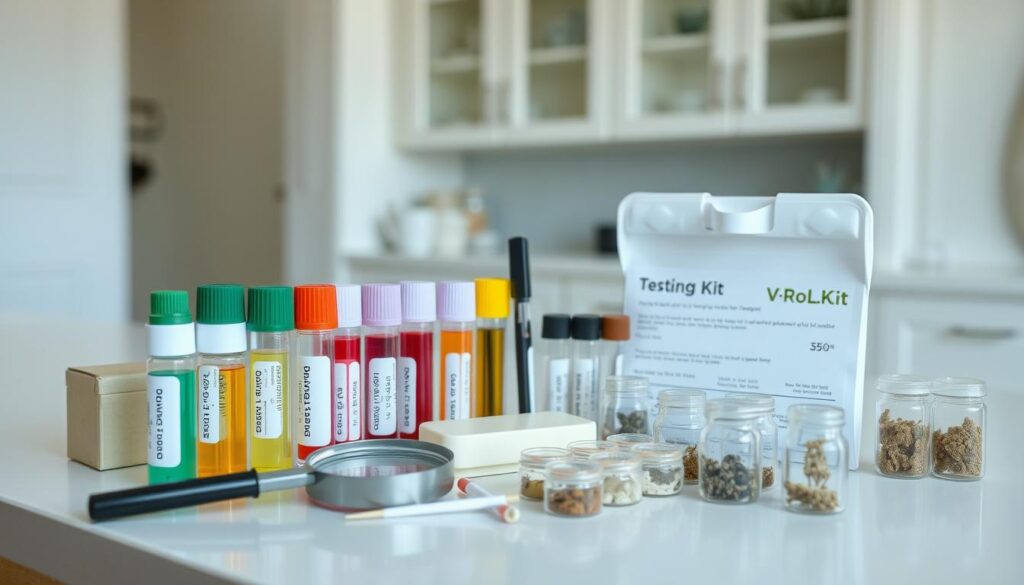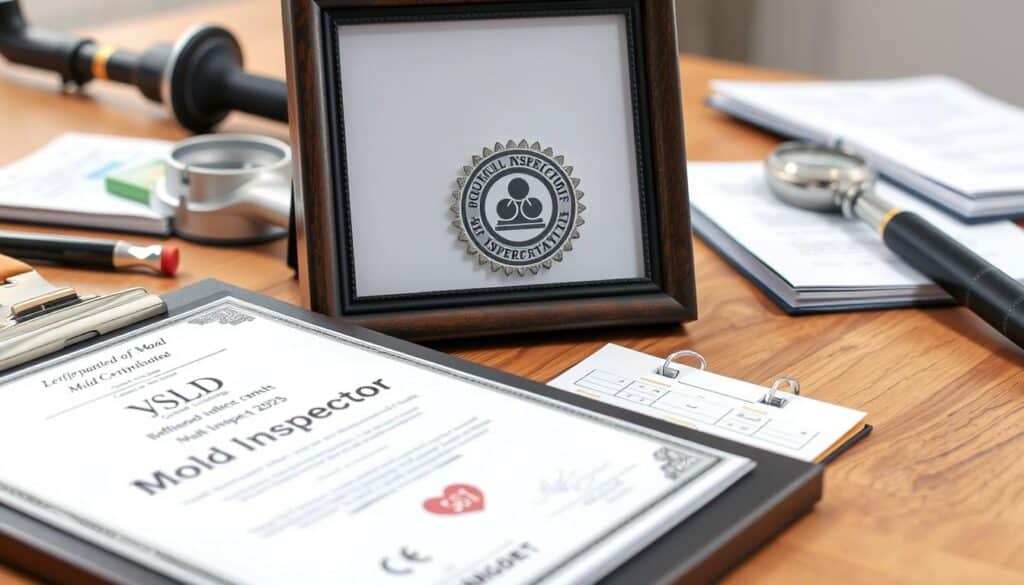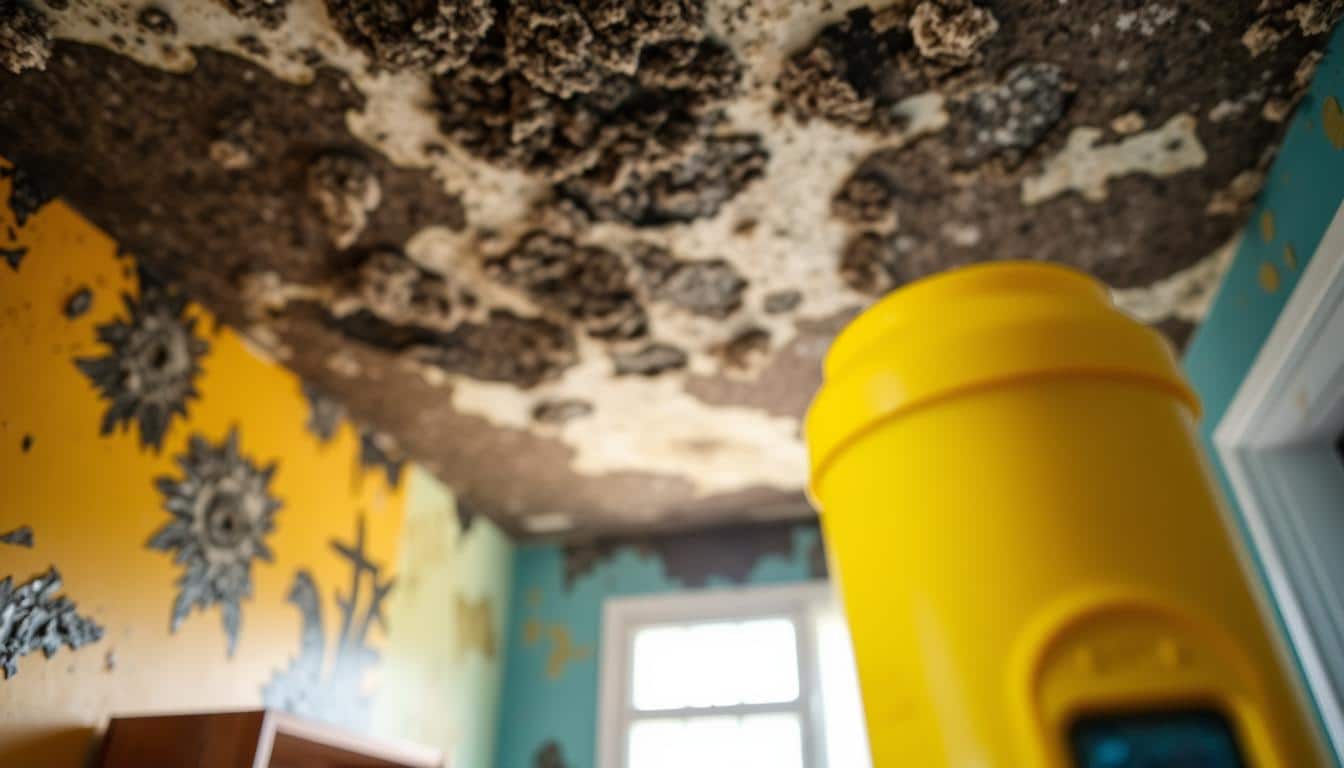More than 80% of home mold test kits give wrong results. This can make people think they have mold when they don’t. Professional mold testing is better and more accurate. It’s especially good for finding hidden moisture that can lead to mold.
Keeping your home healthy is very important. Mold can really hurt the air quality and your health.
In this article, I’ll talk about the good and bad of home mold tests. We’ll look at different types of mold testing. And I’ll tell you when it’s time to call a certified mold inspector. By the end, you’ll know how to find and fix mold problems in your home.
Key Takeaways
- Over 80% of home mold test kits are inaccurate, leading to false conclusions about mold presence.
- Professional mold testing, despite being more expensive, provides reliable and comprehensive results.
- Mold can significantly impact air quality and pose health risks, making detection and remediation crucial.
- Addressing underlying moisture issues is key to effectively eliminating mold growth.
- Hiring a certified mold inspector is recommended to ensure accurate assessment and effective remediation.
Introduction to Mold Testing
Mold is a common problem in many homes. It’s important to know the signs of mold growth. Visible mold can appear as black, green, brown, or white spots or patches on walls, ceilings, and floors.
This type of mold growth can cause structural damage. It can also lead to various health issues, such as respiratory problems, allergic reactions, and even neurological effects.
Visible Mold: Signs and Effects
If you notice visible mold in your home, it’s crucial to address the issue promptly. Mold can cause significant structural damage. It can also compromise the indoor air quality, leading to a range of health symptoms.
- Sneezing
- Coughing
- Itchy eyes
- Runny nose
These health issues can be particularly problematic for individuals with allergies or respiratory conditions. Prompt mold remediation is a top priority.
Musty Odors and Health Symptoms
In addition to visible mold, a musty odor can also be an indicator of mold growth. This musty smell can signal the presence of mold, even if it’s not visible. Mold may be hidden behind walls, under floors, or in other hard-to-reach areas.
If you or your family members are experiencing persistent health symptoms, such as those mentioned above, mold may be the underlying cause.
| Mold Testing Metric | Cost Range |
|---|---|
| Air Sampling | $150 – $300 per sample |
| Surface Sampling | $50 – $150 per sample |
| Bulk Sampling | $50 – $250 per sample |
| Culture and DNA Testing | $100 – $500 per sample |
Understanding these signs of mold growth can help you determine when it’s time to consider professional mold testing. This can help identify the extent of the problem and develop an effective remediation plan.
When to Consider Mold Testing
Even if you haven’t seen any mold or felt sick, there are times when testing is needed. Mold can hide, and tests help you understand your home’s health.
After Water Damage or Flooding
Water damage, like floods or leaks, means your home needs mold testing. Moisture is key for mold growth. After water damage, it’s vital to check for mold.
Before Buying a New Home
Thinking about buying a new home? Get it tested for mold first. Mold tests cost a few hundred to a few thousand dollars. They’re worth it to protect your home’s value and health.
In places like New York, sellers don’t have to fix mold before selling. So, a professional check is crucial to find hidden mold.
If you’ve had mold removed, test it to make sure it’s gone. Testing is not needed if you see mold. But, it’s useful for real estate, health concerns, or indoor air quality checks.
“Mold inspections can be considered an investment to protect the value of your new home and your family’s health.”
Types of Mold Testing
There are different ways to find and fix mold problems in your home. Mold testing takes samples from inside your home. It checks for mold spores and how much there are. The main ways to test include air, surface, and bulk sampling.
Air Sampling for Mold Spores
Air sampling is the most common method. It collects air from various spots in your home. Then, a lab analyzes it to find out what mold is there and how much.
Surface and Bulk Sampling
Surface sampling looks at mold on surfaces like walls and furniture. Bulk sampling checks materials like drywall and insulation. These help find where mold is and how to fix it.
| Mold Testing Method | Purpose | Key Benefits |
|---|---|---|
| Air Sampling | Measures airborne mold spore concentrations | Identifies the types and levels of mold present in the indoor environment |
| Surface Sampling | Detects mold growth on surfaces | Pinpoints the source and location of mold colonization |
| Bulk Sampling | Analyzes materials for mold presence | Provides comprehensive information on mold growth within building materials |
Using these mold testing methods helps understand mold problems well. This way, people can fix and prevent mold issues effectively.
Are home mold tests worth it
Deciding whether to use DIY mold tests or get a professional inspection can be tough. Home test kits are cheaper, costing between $10 and $150. But, they might not be as accurate as what a pro can do.
Professional mold testing offers a deeper look. Inspectors use special methods like air and surface sampling. They find out what kind of mold you have and how much. This info is key for fixing the mold problem right.
DIY tests, on the other hand, just tell you if mold is there. They don’t say what kind or how bad it is. This makes it hard to really fix the mold problem.
Professional testing costs more, from $300 to $1,000 or more. It depends on your home’s size and how complex the test is. But, getting a precise and detailed test can be worth it. It helps keep your home safe and healthy.
Whether to get home mold tests or a pro inspection depends on several things. It’s about how bad the mold problem is, your budget, and how worried you are about mold’s effects. By thinking it through, you can choose what’s best for your home and your health.

“The relationship between mold and human disease is inconclusive, and the EPA has no standards or threshold limit values for airborne concentrations of mold or mold spores.”
Cost of Professional Mold Testing
Professional mold testing is key when dealing with mold in your home. The cost can change based on the testing methods used. It’s good to know what you might pay.
Air sampling, a common test, costs between $150 to $300 per sample. Surface sampling, which takes samples from surfaces, costs $50 to $150 per sample. Bulk sampling, for materials like drywall, can cost $50 to $250 per sample.
More detailed tests like culture and DNA testing cost more. Culture testing and DNA testing can cost $100 to $500 per sample.
The total cost for mold testing varies. It depends on your home’s size, the number of samples, and the tests needed. On average, it can cost $300 to $1,000 or more.
Testing for dangerous mold types, like black mold, can increase costs. This is because these molds require special handling and can pose health risks.
Even though mold testing costs can be high, it’s a smart investment. It ensures your home and family are safe. Testing helps find the problem’s extent, guides fixing it, and prevents damage and health issues later.
| Mold Testing Method | Cost Range |
|---|---|
| Air Sampling | $150 – $300 per sample |
| Surface Sampling | $50 – $150 per sample |
| Bulk Sampling | $50 – $250 per sample |
| Culture Testing | $100 – $500 per sample |
| DNA Testing | $100 – $500 per sample |
The total cost for mold testing can be $300 to $1,000 or more. This depends on your home’s size, the number of samples, and the tests needed.
Hiring a Certified Mold Inspector
When you have mold in your home, it’s important to get help from a certified mold inspector. They know how to find, identify, and fix mold problems. Make sure the inspector is not connected to any mold removal services. This way, their advice is based only on what they find.
Credentials and Certifications to Look For
When looking for a mold inspector, check their credentials and certifications. A certification from the American Council for Accredited Certification (ACAC) shows they have the right skills. They can spot mold and suggest the best ways to get rid of it.
- Look for inspectors with certifications like Certified Mold Inspector (CMI) or Certified Microbial Consultant (CMC).
- Make sure they are up-to-date with the latest mold testing and removal methods.
- Check if they have experience with detailed mold inspections and using special tools.

Choosing a certified mold inspector with the right mold inspector credentials and mold inspector certifications is key. It ensures your mold problems are found and fixed right.
What to Expect During Mold Testing
If you think there’s mold in your home, the first thing to do is get a professional mold inspection. This detailed process includes several important steps. Let me explain what you can expect during a mold test.
The mold inspector will start with a chat to understand your worries and find where mold might be. They’ll then do a close look at your home for any mold or water damage signs.
Depending on the test you choose, the inspector might take air, surface, or bulk samples. These samples go to a lab for a detailed check. The lab will tell you what kind of mold is there and how much mold spores are in the air.
After the lab finishes its work, the inspector will explain the results to you. They’ll give you a detailed report. This report will show how bad the mold problem is, what types of mold are there, and how to fix it to keep your home safe and healthy.
“Around 70% of homes in the United States contain mold, highlighting the widespread prevalence of indoor mold issues.”
Knowing about the mold inspection process helps you deal with mold in your home better. Remember, it’s important to fix mold problems fast. This is because [long-term exposure to mold can cause serious health issues].
Understanding Mold Test Results
When you get mold test results, it’s key to know the difference between viable and non-viable sampling. Non-viable sampling just shows if mold spores are there. It doesn’t tell if they’re alive or dead, or what kind they are. Viable sampling, however, grows the sample to find both live and dead spores. This gives you a clearer picture of the mold types and how fast they grow.
Viable vs. Non-Viable Sampling
Viable sampling gives deeper insights, but it might miss certain types of mold, like Stachybotrys. It also shows how many mold spores there are. This info helps figure out how bad the problem is and how to fix it. Knowing how mold testing works helps you make better choices to solve mold problems at home.
| Viable Sampling | Non-Viable Sampling |
|---|---|
| Cultures the sample to identify both live and dead spores | Identifies the presence of mold spores without differentiating between live and dead |
| Provides more detailed information about the types of mold present and their growth rates | May miss heavy or sticky dead spores, like Stachybotrys |
| Offers a comprehensive assessment of the mold situation | Lacks the ability to determine the specific mold species |
By grasping the details of mold test results, people can make better choices about tackling mold in their homes.
“DIY mold test kits may provide a preliminary indication of mold presence, but they are inadequate for comprehensive mold inspections, which require a combination of visual assessments, air sampling, and surface sampling techniques.”
DIY Mold Testing Kits
DIY mold testing kits seem like a handy and affordable way to find mold at home. But experts often doubt their accuracy. These kits cost between $10 and $150, but they might not fully show the extent of the mold issue.
One big issue with these kits is they can’t tell you exactly what kind of mold you have. They use simple methods like agar plates, which might not count mold spores right. Plus, many things can affect how the test works, leading to wrong results.
Groups like the American Industrial Hygiene Association (AIHA) and the American Conference of Government Industrial Hygienists (ACGIH) advise against using these kits. They say professional checks are key. Without the right tools and eyes, DIY tests can be useless, wasting money and leading to wrong fixes.
Consumer Reports also warns against DIY mold test kits. They point out problems like leaks, contamination, and wrong mold spore finds. They say the best way to get right results is through certified experts.
Even though DIY kits might look good, their flaws and possible mistakes are big concerns. If you think you have a mold problem, it’s best to get a pro to test it. This way, you’ll get accurate results and the right fix.
“Without a thorough visual inspection and the use of specialized equipment, the results from DIY mold testing kits can be meaningless, potentially leading to wasted expenses and incorrect remediation efforts.”
Conclusion
Whether home mold tests are worth it depends on your home’s situation and the mold problem’s severity. DIY kits can give some info, but professional tests offer more accurate results. These are key for fixing the mold issue.
When thinking about mold testing, consider the risks to your health and home. If you think you have a big mold issue or worry about your family’s health, get a professional mold test. Work with a certified mold inspector to keep your home safe and healthy.
The key takeaways are that DIY kits might seem cheaper, but professional mold inspections give a full picture. They help find the real problem and guide the mold remediation process. Your decision to get mold testing should match your concerns and the risks to your home and family.
FAQ
What are the signs of mold growth in a home?
Mold shows up as black, green, brown, or white spots on walls, ceilings, and floors. A musty smell can also mean mold is present, even if you can’t see it. Sneezing, coughing, and watery eyes are signs of mold too.
When should I consider mold testing in my home?
You might want to test for mold if your home has had water damage. This includes floods or leaks. Also, if you’re buying a new home or have had mold removed, testing is a good idea.
What are the different types of mold testing?
There are three main types of mold testing. Air sampling checks the air for mold spores. Surface sampling takes samples from surfaces. Bulk sampling tests materials like drywall or insulation.
Are home mold tests worth the investment?
Whether to get mold tests depends on the problem’s severity, your budget, and your health concerns. DIY kits are cheaper but might not be as accurate as professional tests. Professional tests give more detailed and reliable results.
How much does professional mold testing cost?
Professional mold testing prices vary. Air sampling costs $150 to $300 per sample. Surface sampling is $50 to $150 per sample. Bulk sampling is $50 to $250 per sample. Total costs can be $300 to $1,000 or more.
What should I look for when hiring a certified mold inspector?
Look for a certified mold inspector who is independent. They should not work with remediation services. Check for certifications from organizations like the American Council for Accredited Certification (ACAC).
What can I expect during a professional mold inspection?
A mold inspection starts with a consultation. Then, a visual check is done. Samples might be collected for analysis. After the lab results, you’ll get a detailed report with mold types, concentrations, and remediation advice.
How do I interpret mold test results?
Understanding mold test results is key. Viable sampling finds live and dead mold spores. Non-viable sampling only finds spores, not differentiating between live and dead. The results show mold spore concentration, helping to gauge the problem’s severity.
Are DIY mold testing kits reliable?
DIY kits are cheaper but less reliable than professional tests. They can tell you if mold is present but might not identify mold types or the full extent of the problem. For serious mold issues, professional testing is usually best.
What should I look for when hiring a certified mold inspector?
Look for a certified mold inspector who is independent. They should not work with remediation services. Check for certifications from organizations like the American Council for Accredited Certification (ACAC).
What can I expect during a professional mold inspection?
A mold inspection starts with a consultation. Then, a visual check is done. Samples might be collected for analysis. After the lab results, you’ll get a detailed report with mold types, concentrations, and remediation advice.
How do I interpret mold test results?
Understanding mold test results is key. Viable sampling finds live and dead mold spores. Non-viable sampling only finds spores, not differentiating between live and dead. The results show mold spore concentration, helping to gauge the problem’s severity.
Are DIY mold testing kits reliable?
DIY kits are cheaper but less reliable than professional tests. They can tell you if mold is present but might not identify mold types or the full extent of the problem. For serious mold issues, professional testing is usually best.




